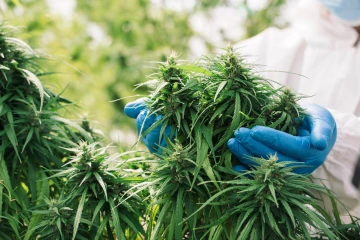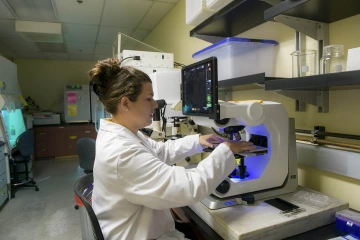Uncovering a Connection Between Cannabinoids and Migraine
Researchers in the Comprehensive Center for Pain and Addiction are seeking new therapies for migraine in an unlikely place – the endogenous cannabinoid system.
Migraine can be one of the most difficult pain conditions to treat, because no one knows what causes it. Experts have found that different people have different triggers – stress, sleep issues, weather, diet, light or smell, for example. But the physiological basis for migraine, which affects more than 1 billion people worldwide, remains a mystery.
Researchers at the University of Arizona Health Sciences Comprehensive Center for Pain and Addiction are tracking the molecular steps that lead to migraine with the hope of developing better preventative and therapeutic options. One of the most promising areas of research is the endogenous cannabinoid system.
Understanding the endogenous cannabinoid system
Cannabinoids, compounds found in the Cannabis sativa plant, have long been used to treat various maladies including pain. The two primary active cannabinoids, THC and CBD, are considered exogenous cannabinoids because they originate from outside the body. Cannabinoids that originate from within the body are called endocannabinoids.

Tally Largent-Milnes, PhD, is studying the role of the endogenous cannabinoid system in migraine, a neurological disorder that affects women at a higher rate than men.
Cannabinoids act by binding to CB1 and CB2 receptors, located on nerve cells in the central and peripheral nervous systems. The activation of the receptors causes the cell to take action, such as reducing inflammation or relieving pain. When the desired effect is achieved, enzymes break down the cannabinoids, both exogenous and endocannabinoids, removing them from the body. The various components work together to form the endogenous cannabinoid system.
“There is clinical evidence that patients who have chronic migraine, defined as 15 or more headache days per month, as well as patients who have medication-overuse headache, have lower circulating plasma levels of endocannabinoids,” said Tally Largent-Milnes, PhD, an associate professor of pharmacology in the UArizona College of Medicine – Tucson and member of the UArizona Health Sciences Comprehensive Pain and Addiction Center.
Dr. Largent-Milnes studied the endogenous cannabinoid system as a junior faculty member under the mentorship of Todd Vanderah, PhD, head of the Department of Pharmacology, interim director of the Comprehensive Pain and Addiction Center and BIO5 Institute member. She was intrigued by the connection to migraine, a condition both she and her mother have.
“Clinical endocannabinoid deficiency is a common feature between the three major functional pain disorders: migraine, fibromyalgia and irritable bowel,” Dr. Largent-Milnes said. “The other common thing with all three is that they predominantly affect females. From a pharmacology standpoint and based on what studies had been done, we knew that there were sex differences in how cannabis and other compounds work at the cannabinoid receptors, laying the foundation for further research.”

The human body recognizes the compounds found in cannabis because of the body’s natural endogenous cannabinoid system, which is found throughout the central nervous system, including the brain and spinal cord, and the peripheral nervous system.
Two primary endocannabinoids have been identified: anandamide, which in 1992 was the first one to be discovered, and 2-arachidonoylglycerol, or 2-AG.
“There have been studies in migraine models that have asked, ‘Can we block anandamide degradation by targeting the enzyme with a drug to alleviate headache?’ And the answer to that is yes,” Dr. Largent-Milnes said. “That line of research came from this idea of clinical endocannabinoid deficiency, and the fact that we can measure anandamide levels in both the central nervous system and the blood plasma. But the 2-AG story has been largely overlooked, and my lab is primarily interested in 2-AG due to its increased endogenous levels.”
Looking at the link between endocannabinoids and migraine
Migraine, which is classified as a neurological disorder, occurs most often among people aged 20 to 50 years and is about three times more common in women than in men, according to the Journal of the American Medical Association. Research in the U.S. has shown that 17.1% of women reported having migraine symptoms, yet only 5.6% of men say the same.
One potential explanation is the differences in the endocannabinoid levels of men and women.
“Clinical endocannabinoid deficiency is a common feature between the three major functional pain disorders: migraine, fibromyalgia and irritable bowel.”Tally Largent-Milnes, PhD
“In our preclinical studies we found that both anandamide and 2-AG levels are lower in females, specifically in the periaqueductal gray region of the brain,” Dr. Largent-Milnes said, explaining that the periaqueductal gray acts to amplify or dampen the perception of stressors including pain.
With the knowledge that females have lower levels of endocannabinoids overall, researchers in Dr. Largent-Milnes’ lab examined whether there was a correlation between endocannabinoid levels and migraine headaches. The answer was a resounding yes. In animal migraine models, 2-AG levels were lower in the migraine headache group than in the non-headache group.
“We are seeing a variety of changes in the molecular components of migraine – especially in the enzyme activities, receptors and inflammatory markers – that point to this idea that 2-AG is playing a role,” Dr. Largent-Milnes said. “The losses of 2-AG that we see are not due to any changes in how much is being made, but rather how much is being degraded. It really pushes forth this idea that enhanced degradation of 2-AG may be a driving factor for headache.”
Dr. Largent-Milnes’ ongoing research is focusing on manipulating the endocannabinoid enzymes to increase 2-AG levels. She has early evidence to suggest that headache-like pain can by reduced by inhibiting specific enzymes that break down 2-AG.

Dr. Largent-Milnes’ migraine research focuses on the degradation of the endocannabinoid 2-arachidonoylglycerol, or 2-AG.
If her theory is successful, it opens the door for the creation of drugs that can influence the endocannabinoid system without the negative side effects of cannabis, including mood and behavioral changes and addiction.
She also is examining endocannabinoid levels during different life stages, including pre-puberty and post-menopause. One of the projects she hopes to get funded will examine if and how estrogen regulates the endocannabinoid system in pain relevant to the brain regions.
“From the sex difference standpoint, this seems to be a female-mediated system, so it’s likely, at least in part, that a hormone regulation of the endocannabinoid system is what's driving this female susceptibility to headache,” Dr. Largent-Milnes concluded.
By targeting the endogenous cannabinoid system using compounds to boost natural endocannabinoids including 2-AG, Dr. Largent-Milnes hopes to develop new and potentially sex-selective preventative and therapeutic drugs for migraine.

